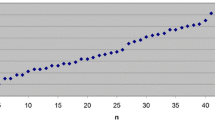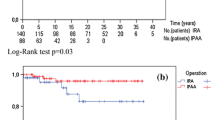Abstract
PURPOSE: Virtually all untreated patients with familial adenomatous polyposis develop colorectal carcinoma. Thus, prophylactic colectomy is indicated. Detractors of ileal pouch-anal anastomosis prefer ileorectal anastomosis for teenagers because of the potential negative impact of ileal pouch-anal anastomosis on quality of life. The aim of this study was to assess the effects on quality of life of ileal pouch-anal anastomosis in teenagers with familial adenomatous polyposis. METHODS: Between 1981 and 1998, 48 teenagers underwent ileal pouch-anal anastomosis for familial adenomatous polyposis. One patient had proctectomy and ileal pouch-anal anastomosis after previous ileorectal anastomosis. A temporary diverting loop ileostomy was established in 42 patients (87.5 percent). One patient had colonic carcinoma diagnosed preoperatively. Two other patients were found to have unsuspected rectal cancer at surgery. Mean follow-up (± standard deviation) in 43 patients was 80.5±42 months. RESULTS: There was no immediate postoperative mortality. Postoperative complications included pelvic sepsis (3 patients; 1 requiring reoperation) and bleeding (1 patient; no surgery required). One patient died of metastatic colonic carcinoma. Ten patients required reoperation, seven had bowel obstruction, one had portal hypertension, and two required an ileostomy. The mean (± standard deviation) daytime and nighttime stool frequency was 4±1.5 and 1±1, respectively. One patient reported daytime and nighttime incontinence, and two patients reported nighttime incontinence only. No patient experienced impotence or retrograde ejaculation. Social, sexual, sport, housework, recreation, family, travel, and work activities were improved or unchanged in 82.5, 87, 80, 90, 80, 92.5, 77.5, and 89 percent of patients, respectively. Three male patients fathered children, and three female patients had a total of six children after normal pregnancies and deliveries. CONCLUSION: The impact of ileal pouch-anal anastomosis on quality of life was favorable in the majority of teenagers. The risk of rectal cancer should be the major consideration before proposing an operation to teenagers with familial adenomatous polyposis.
Similar content being viewed by others
References
Kinzler K, Nilbert M, Su L,et al. Identification of FAP locus genes from chromosome 5q21. Science 1991;253:661–5.
Groden J, Thliveris A, Samowitz W,et al. Identification and characterization of the familial adenomatosis polyposis coli gene. Cell 1991;66:589–600.
Bussey HJ. Familial polyposis coli: family studies, histopathology, differential diagnosis and results of treatment. Baltimore: The John Hopkins University Press, 1975.
Newton CR, Baker WN. Comparison of bowel function after ileorectal anastomosis for ulcerative colitis and colonic polyposis. Gut 1975;16:785–91.
Nugent KP, Phillips RK. Rectal cancer risk in older patients with familial adenomatous polyposis ans an ileorectal anastomosis: a cause for concern. Br J Surg 1992;79:1204–6.
Ambroze WL, Dozois RR, Pemberton JH, Beart RW Jr, Ilstrup DM. Familial adenomatous polyposis: results following ileal pouch-anal anastomosis and ileorectostomy. Dis Colon Rectum 1992;35:12–5.
Kartheuser AH, Parc R, Penna CP,et al. Ileal pouch-anal anastomosis as the first choice operation in patients with familial adenomatous polyposis: a ten-year experience. Surgery 1996;119:615–23.
Phillips RK, Spigelman AD. For debate: can we safely delay or avoid prophylactic colectomy in familial adenomatous polyposis? Br J Surg 1996;83:769–70.
Köhler LW, Pemberton JH, Zinsmeister AR, Kelly KA. Quality of life after proctocolectomy. Gastroenterology 1991;101:679–84.
Ziv Y, Church JM, Oakley JR, McGannon E, Fazio VW. Surgery for the teenager with familial adenomatous polyposis: ileorectal anastomosis or restorative proctocolectomy? Int J Colorectal Dis 1995;10:6–9.
Tonelli F, Valanzano R, Monaci I, Mazzoni P, Anastasi A, Ficari F. Restorative proctocolectomy or rectumpreserving surgery in patients with familial adenomatous polyposis: results of a prospective study. World J Surg 1997;21:653–9.
Francois Y, Dozois RR, Kelly KA,et al. Small intestinal obstruction complicating ileal pouch-anal anastomosis. Ann Surg 1989;209:46–50.
Flanagan JC. Measurement of quality of life: current state of the art. Arch Phys Med Rehab 1982;63:56–9.
Pemberton JH, Phillips SF, Ready RR, Zinsmeister AR, Beahrs OH. Quality of life after Brooke ileostomy and ileal pouch-anal anastomosis: comparison of performance status. Ann Surg 1989;209:620–6.
Demographic Yearbook. New York: United Nations Publishing Division, 1999, 1997.
De Cosse JJ, Bulow S, Neale K,et al. Rectal cancer risk in patients treated for familial adenomatous polyposis. Br J Surg 1992;79:1372–5.
Penna C, Kartheuser A, Parc R,et al. Secondary proctectomy and ileal pouch-anal anastomosis after ileorectal anastomosis for familial adenomatous polyposis. Br J Surg 1993;80:1621–3.
Heiskanen I, Jarvinen H. Fate of the rectal stump after colectomy and ileorectal anastomosis for familial adenomatous polyposis. Int J Colorectal Dis 1997;12:9–13.
Gardiello FM, Hamilton SR, Krush AJ,et al. Treatment of colonic and rectal adenomas with Sulindac in familial adenomatous polyposis. N Engl J Med 1993;328:1313–6.
Giardello FM, Offerhaus JA, Tersmette AC,et al. Sulindac induced regression of colorectal adenomas in familial adenomatous polyposis: evaluation of predictive factors. Gut 1996;38:578–81.
Ziv Y, Fraser GM. Adenocarcinoma in the rectal segment in familial polyposis coli is not prevented by sulindac therapy. Gastroenterology 1994;107:854–7.
Spagnesi MT, Tonelli F, Dolara P,et al. Rectal proliferation and polyp occurrence in patients with familial adenomatous polyposis after sulindac treatment. Gastroenterology 1994;106:362–6.
Wu JS, McGannon EA, Church JM. Incidence of neoplastic polyps in the ileal pouch of patients with familial adenomatous polyposis after restorative proctocolectomy. Dis Colon Rectum 1998;41:552–7.
Hoehner JC, Metcalf AM. Development of invasive adenocarcinoma following colectomy with ileoanal anastomosis for familial polyposis coli. Dis Colon Rectum 1994;37:824–8.
Bassuini MM, Billings PJ. Carcinoma in an ileoanal pouch after restorative proctocolectomy for familial adenomatous polyposis [abstract]. Br J Surg 1996;83:506.
Von Herbay A, Stern J, Herfarth C. Pouch-anal cancer after restorative proctocolectomy for familial adenomatous polyposis. Am J Surg Pathol 1996;20:995–9.
Vasen HF, Van der Luijt RB, Slors JF,et al. Molecular genetic tests as a guide to surgical management of familial adenomatous polyposis. Lancet 1996;348:433–5.
Wu JS, Philip P, McGannon EA, Church JM. APC genotype, polyp number, and surgical options in familial adenomatous polyposis. Ann Surg 1998;227:57–62.
Author information
Authors and Affiliations
About this article
Cite this article
Parc, Y.R., Moslein, G., Dozois, R.R. et al. Familial adenomatous polyposis. Dis Colon Rectum 43, 893–898 (2000). https://doi.org/10.1007/BF02237346
Issue Date:
DOI: https://doi.org/10.1007/BF02237346




